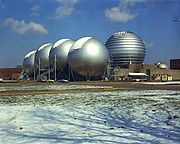
Hypersonic wind tunnel
Encyclopedia

Hypersonic
In aerodynamics, a hypersonic speed is one that is highly supersonic. Since the 1970s, the term has generally been assumed to refer to speeds of Mach 5 and above...
flow field in the working section. The speed of these tunnels vary from Mach
Mach number
Mach number is the speed of an object moving through air, or any other fluid substance, divided by the speed of sound as it is in that substance for its particular physical conditions, including those of temperature and pressure...
5 to 15. As with supersonic wind tunnels, these types of tunnels must run intermittently with very high pressure ratios when initializing.
Since the temperature drops with the expanding flow, the air inside has the chance of becoming liquefied. For that reason, preheating is particularly critical (the nozzle may require cooling). High pressure and temperature ratios can be produced with a shock tube
Shock tube
For the pyrotechnic initiator, see Shock tube detonatorThe shock tube is an instrument used to replicate and direct blast waves at a sensor or a model in order to simulate actual explosions and their effects, usually on a smaller scale...
.
Technological problems
There are several technological problems in designing and constructing a hyper-velocity wind tunnel:- supply of high temperatures and pressures for times long enough to perform a measurement
- reproduction of equilibrium conditions
- structural damage produced by overheating
- fast instrumentation
- power requirements to run the tunnel
Simulations of a flow at 5.5 km/s, 45 km altitude would require tunnel temperatures of as much as 9000 K
Kelvin
The kelvin is a unit of measurement for temperature. It is one of the seven base units in the International System of Units and is assigned the unit symbol K. The Kelvin scale is an absolute, thermodynamic temperature scale using as its null point absolute zero, the temperature at which all...
, and a pressure of 3 GPa (see discussion).
Hot shot wind tunnel
One form of HWT is known as a Gun Tunnel or hot shot tunnel (up to M=27), which can be used for analysis of flows past ballistic missiles, space vehicles in atmospheric entry, and plasma physics or heat transfer at high temperatures. It runs intermittently, like other high speed tunnels, but has a very low running time (less than a second).The method of operation is based on a high temperature and pressurized gas (air or nitrogen) produced in an arc-chamber, and a near-vacuum in the remaining part of the tunnel. The arc-chamber can reach several MPa, while pressures in the vacuum chamber can be as low as 0.1 Pa
Pascal (unit)
The pascal is the SI derived unit of pressure, internal pressure, stress, Young's modulus and tensile strength, named after the French mathematician, physicist, inventor, writer, and philosopher Blaise Pascal. It is a measure of force per unit area, defined as one newton per square metre...
. This means that the pressure ratios of these tunnels are in the order of 10 million. Also, the temperatures of the hot gas are up to 5000 K. The arc chamber is mounted in the gun barrel. The high pressure gas is separated by the vacuum by a diaphragm that breaks down as its resistance is exceeded.
Prior to a test run commencing, a membrane separates the compressed air from the gun barrel breech. A rifle (or similar) is used to rupture the membrane. Compressed air rushes into the breech of the gun barrel, forcing a small projectile to accelerate rapidly down the barrel. Although the projectile is prevented from leaving the barrel, the air in front of the projectile emerges at hypersonic velocity into the working section. Naturally the duration of the test is extremely brief, so high speed instrumentation is required to get any meaningful data.
See also
- Wind tunnelWind tunnelA wind tunnel is a research tool used in aerodynamic research to study the effects of air moving past solid objects.-Theory of operation:Wind tunnels were first proposed as a means of studying vehicles in free flight...
- Low speed wind tunnel
- High speed wind tunnel
- Supersonic wind tunnel
- Ludwieg tubeLudwieg tubeA Ludwieg tube is a cheap and efficient way of producing supersonic flow. Mach numbers up to 4 are easily obtained without any additional heating of the flow. With heating, Mach numbers of up to 11 can be reached.-Principle:...
- Shock tubeShock tubeFor the pyrotechnic initiator, see Shock tube detonatorThe shock tube is an instrument used to replicate and direct blast waves at a sensor or a model in order to simulate actual explosions and their effects, usually on a smaller scale...
- HypersonicHypersonicIn aerodynamics, a hypersonic speed is one that is highly supersonic. Since the 1970s, the term has generally been assumed to refer to speeds of Mach 5 and above...
- NASANASAThe National Aeronautics and Space Administration is the agency of the United States government that is responsible for the nation's civilian space program and for aeronautics and aerospace research...
External links
- Hot Shot Wind Tunnel at the Von Karman Institute for Fluid DynamicsVon Karman Institute for Fluid DynamicsThe von Karman Institute for Fluid Dynamics is a non-profit educational and scientific organization which specializes in three specific fields: aeronautics and aerospace, environment and applied fluid dynamics, turbomachinery and propulsion...

